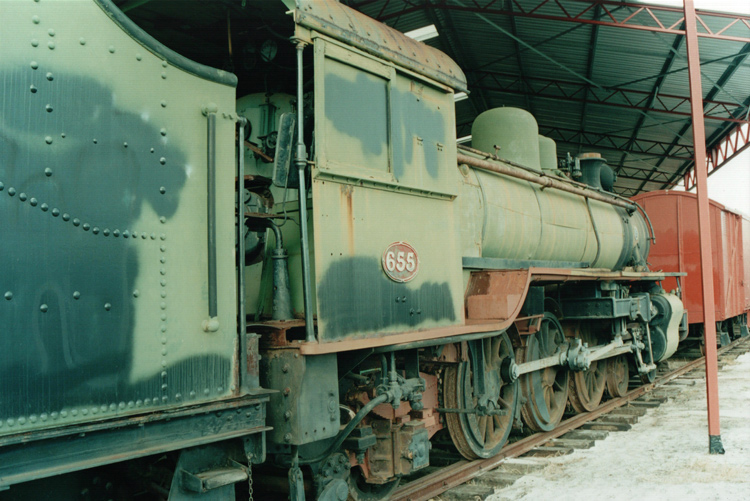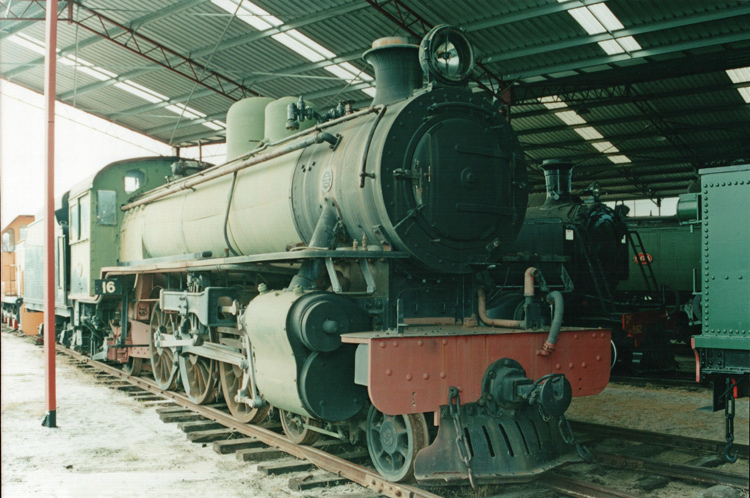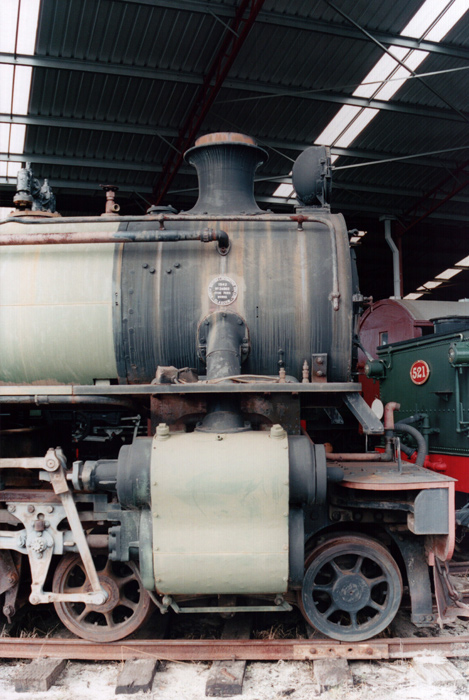|
|
U 655 The Railway Museum, Bassendean |
|

U 655 displayed at The Railway Museum, Bassendean on 9 May
2002.
The cab window screen (closed in this
view) possibly reflects the wartime heritage of the U class.
Alas U 655 had been defaced with graffiti
at some stage prior to my visit, which can be seen hastily painted over.
More recent photos show WA Rail Heritage volunteers have
since provided the loco with a full cosmetic restoration.
|
Builder |
North British Locomotive Company, Glasgow |
|
Builder’s Number & Year |
24863 of 1942 |
|
Wheel Arrangement |
4-6-2 |
|
No. in class |
14 |
|
Entered Service |
25 January 1947 |
|
Date Withdrawn |
10 September 1970 |
|
U Class The WAGR U
class locomotives have a particularly interesting and international
antecedence, being constructed by the North British Locomotive Company in
1942 to a UK War Department order for 55 oil-burning locos as their ‘2800
series Pacifics’ intended for use in North Africa and other theatres with 3’
6” gauge trackage. The design was based on the proven ‘220-class’ of the
Sudan Government Railways, 16 of which were built before World War 2 by
Kitson and North British (Sudan Railways Nos.220 - 235) followed by 35 War
Department units (Sudan Railways Nos.236 - 270). Whilst I haven’t yet found a
definitive history of Sudan Government Railways steam locomotives, photos
show their Pacifics operated within an interesting fleet of British-built
locos that might have looked equally at home in Australia. Against
this background and in need of rebuilding their locomotive fleet after World
War 2, in 1946 the WAGR took advantage of war surplus equipment to purchase
14 unused WD Pacifics from the British Ministry of Munitions, among 20 that
were stored unassembled in the UK. (The remaining 6 war surplus WD 2800
series Pacifics were sold to the Trans-Zambesi Railway in southern Africa.) The 14
members of the WAGR U class did not follow usual WAGR practice not only as
oil-burners, but also in having American-style bar frames rather than
British-style plate fames. With a relatively high axle load of 11.5 tons, the
U-class were restricted to main lines with heavier rail. (Presumably another
factor limiting operating range would have been the availability of oil
refuelling facilities.) The class found success on passenger and goods duties
on the route south from Perth to Bunbury, notably on the ‘Australind’
express, and the longer route from Perth to Albany. (The intriguing name
‘Australind’ is a concatenation of ‘Australia’ and ‘India’, referencing a
town on the Leschenault Inlet not far from Bunbury – although the town of
Australind never featured a railway line or station!) As
oil-burners the U-class were always more expensive to run than locomotives
that consumed the local Collie coal, and hence were placed out of service in
1957 following the arrival of first-generation diesels. U 664 had been
converted to coal firing in 1954, but no further class conversions followed.
U 664 was subsequently rebuilt to 4-6-4T configuration in 1957, becoming Ut
664. (Interestingly, Ut 664 reverted to oil firing as part of the tank engine
conversion.) It seems WAGR management considered the U-class as useful
insurance against the risk of disruption to coal supplies and so were kept in
store, some seeing occasional further use during the 1960’s. Twelve class
members were officially withdrawn on 6 October 1969 but this seems to be a
book entry rather than a date reflecting their final day in steam. U 655 U 655
seems to be the lucky class member as it was released from storage and
employed in shunting service at Bassendean from February 1967 until October
1968. (It would be interesting to know why WAGR management chose to return
one class member to duty.) It outlasted its 12 sisters officially withdrawn
together on 6 October 1969, instead remaining until 10 September 1970. The
U-class is now represented in preservation by U 655 displayed at The Railway Museum,
Bassendean in the care of the Australian Railway Historical Society (WA
Division) – now known as Rail Heritage WA. Also displayed at Bassendean is
the unique U-class tank conversion, Ut
664. U 655
needed a repaint at the time of my visit in May 2002, but more recent photos
show Rail Heritage WA volunteers have since provided the loco with a full
cosmetic restoration. I’m looking forward to a return visit to Bassendean to
take many digital photos of the wonderful locomotive collection there! Sudan
Railways Intrepid
enthusiasts visiting Sudan in the 1980’s photographed 220-class locomotives
still operating with the Sudan Railways, together with modern 4-8-2 and other
oil-burning steam locomotives of various types stowed here and there.
Apparently, Sudan Railway steam continued into the early 1990’s; alas it
seems almost everything has since been scrapped but perhaps a 220-class
example survives lurking in the back of a shed somewhere. If my
memory serves me correctly, another interesting note concerning Sudan
Railways were 6 modern 2-6-2 tender locos that
returned to the UK in 1985 and rapid overhauled, prior to returning to Sudan
and deployed on famine relief trains. This initiative was organised under the
famous ‘Feed the World’ international fundraising effort. Alas it seems these
2-6-2 locos have also since been consigned to history. The Sudan
Railways cousins are an interesting addition to the WAGR U-class story and
hence I would greatly appreciate not only further photographs of U 655 for
addition to this page, but also photos of the Sudan Railways 220-class locos
and the Sudan steam scene of the 1980’s. |

Font view of U 655 displayed at Bassendean on 9 May 2002.
More recent photos show U 655 has since been cosmetically
restored.

U 655 – Front end detail. 9 May 2002

U-class locos stored among other types at
Midland Workshops, circa 1960.
An M-series Beyer-Garratt loco faces the
photographer in the middle row; alas none survived.
Image used with permission of the
wonderful Rail Heritage WA archive:
http://railheritagewa.org.au/archive_scans/displayimage.php?pid=11953
(Image reference T03344, original photographer R. Moss.)

U 653 heads a row of stored sisters at
Midland circa 1960’s.
Other photos taken around this time show
U 659 heads the row alongside.
Image used with permission of the
wonderful Rail Heritage WA archive:
http://railheritagewa.org.au/archive_scans/displayimage.php?pid=7969
(Image reference P12160, original photographer P. Hopper.)

U 655 shunting the Midland Marshalling
Yard, circa 1967-68.
Image used with permission of the
wonderful Rail Heritage WA archive:
http://railheritagewa.org.au/archive_scans/displayimage.php?pid=7215
(Image reference P11406, original photographer P. Hopper.)
References
|
a |
A. Gunzburg
'A history of WAGR steam locomotives', published
by ARHS (Western Australian Division) 1984. |
|
b |
Gray. W.
K., 'Guide
to Rail Transport Museum, Bassendean, Western Australia', Australian
Railway Historical Society W. A. Division, First
Edition November 1999. |
|
c |
Rail
Heritage WA website, Exhibits page: U & Ut class: https://www.railheritagewa.org.au/museum/locos/pages/u-ut_steam.php retrieved 6
January 2023 |
|
d |
North
British Loco Society newsletter, July 2016 |
|
e |
Wikipedia
page for WAGR U-class: https://en.wikipedia.org/wiki/WAGR_U_class retrieved
29 January 2023 |
Page updated: 22 February 2023
|
Government Railways: |
|
|||||||||
|
Private & Industrial Railways: |
|